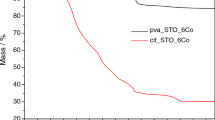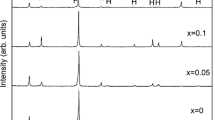Abstract
Undoped and Nb-doped SrTiO3 specimens with excess titania compositions were prepared by sintering in air at 1420 or 1480 °C. Large grains due to liquid-phase sintering were obtained for undoped specimens containing ⩾ 0.6 mol % excess titania and fired at 1480 °C. On the other hand uniform fine grains were observed for samples fired at 1420 °C, resulting from grain-growth inhibition due to exsolved TiO2 second phase. The solubility of excess titania seemed less than 0.2 mol% under our experimental conditions. The microstructural behaviour of Nb-doped SrTiO3 could be explained well by the Sr-vacancy compensation model. According to this model, the solubility of excess titania in SrTiO3 increased with Nb2O5 dopant concentration. Thus, for specimens which had high excess titania compositions and were sintered at 1480 °C, large grains were observed when the Nb content was low enough to retain sufficient excess titania-forming liquid phase. For specimens having the same compositions and fired at 1420 °C, uniform fine grains were obtained due to grain growth inhibition by the exsolved TiO2 second phase, when the Nb content was low. If the excess titania was less than the solubility determined by the amount of Nb dopant, Ruddlesden-Popper-type phases were believed to be formed and resulted in poor densification. Although excess titania was the major factor in determining the grain size of the specimens, the niobium dopant enhanced grain growth.
Similar content being viewed by others
References
G. Goodman, in “Advances in Ceramics”, Vol. 1, edited by L. M. Levinson and D. C. Hill (American Ceramic Society, Westerville, Ohio, 1981) p. 215.
N. Yamaoka and T. Matsui, ibid. p. 232.
H. D. Park and D. A. Payne ibid. p. 242.
V. W. R. Amarakoon, PhD thesis, University of Illinois-Urbana Champaign (1980).
M. S. Wrighton, A. B. Ellis, P. T. Wolczanski, D. L. Morse, H. B. Abrahamson and D. S. Ginley, J. Amer. Chem. Soc. 98 (1976) 2774.
T. Seiyama, H. Arai, H. Niita and K. Yasugata, Japanese Patent 60225051 (1985).
N. H. Chan, R. K. Sharma and D. M. Smyth, J. Electrochem. Soc. 128 (1981) 1762.
S. Witek, D. M. Smyth and H. Pickup, J. Amer. Ceram. Soc. 67 (1984) 372.
N. G. Eror and U. Balachandran, J. Solid State Chem. 42 (1982) 227.
Idem, ibid. 40 (1981) 85.
G. H. Jonker, Solid State Electronics 7 (1964) 895.
W. Heywang, J. Mater. Sci. 6 (1971) 1214.
R. Wernicke, Phys. Status Solidi (a) 47 (1978) 139.
M. Kahn, J. Amer. Ceram. Soc. 54 (1971) 452.
T. Murakami, T. Miyashita, M. Nakahara and E. Sekine, ibid. 56 (1973) 294.
M. Drofenik, A. Popovic and D. Kolar, Amer. Ceram. Soc. Bull. 63 (1984) 702.
K. Lubitz, in “Sintering — Theory and Practice”, Proceedings of 5th International Round Table Conference on Sintering, Portorž, Yugoslavia, 7–10 September 1981, p. 343.
I. Burn and S. Neirman, J. Mater. Sci. 17 (1982) 3510.
M. Raymond, MS thesis, Alfred University (1987).
N. Stenton and M. P. Harmer, in “Advances in Ceramics”, Vol. 7, edited by M. F. Yan and A. H. Heuer (American Ceramic Society, Westerville, Ohio, 1983) p. 156.
R. Wernicke, in “Advances in Ceramics”, Vol. 1, edited by L. M. Levinson and D. C. Hill (American Ceramic Society, Westerville, Ohio, 1981) p. 261.
M. P. Pechini, US Patent 3 330 697 (1967).
S. G. Cho, P. F. Johnson and R. A. Condrate Sr, J. Mater. Sci. 25 (1990) 4738.
E. Underwood, “Quantitative Stereology” (Addison-Wesley, New York, 1970) p. 23.
M. I. Mendelson, J. Amer. Ceram. Soc. 52 (1969) 443.
ASTM C373-72, “Water Absorption, Bulk Density, Apparent Porosity and Apparent Specific Gravity of Fired Whiteware Products” (ASTM, Philadelphia, 1972).
E. M. Levin, C. R. Robbins and H. F. McMurdie, “Phase Diagrams for Ceramists” (American Ceramic Society, Westerville, Ohio, 1964) Figs 297, 298 and 1969 Supplement Fig. 2334.
U. Balachandran and N. G. Eror, J. Electrochem. Soc. 129 (1982) 1021.
S. N. Ruddlesden and P. Popper, Acta. Crystallogr. 11 (1958) 54.
K. R. Udayakumar and A. N. Cormack, J. Phys. Chem. Solids. 50 (1989) 55.
A. E. Paladino, J. Amer. Ceram. Soc. 48 (1965) 476.
S. G. Cho and P. F. Johnson, Ferroelectrics 132 (1992) 115.
Author information
Authors and Affiliations
Rights and permissions
About this article
Cite this article
Cho, S.G., Johnson, P.F. Evolution of the microstructure of undoped and Nb-doped SrTiO3 . Journal of Materials Science 29, 4866–4874 (1994). https://doi.org/10.1007/BF00356536
Received:
Accepted:
Published:
Issue Date:
DOI: https://doi.org/10.1007/BF00356536




